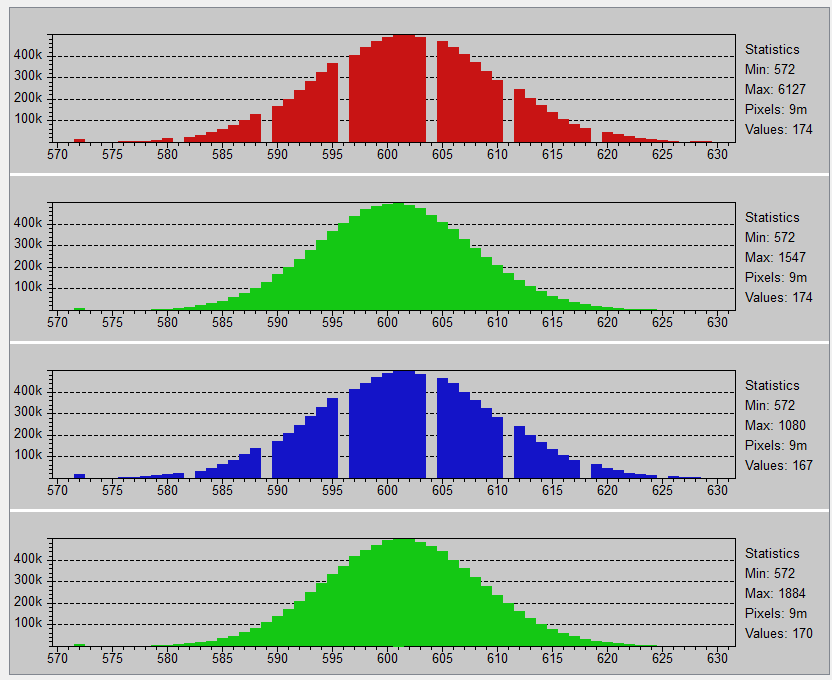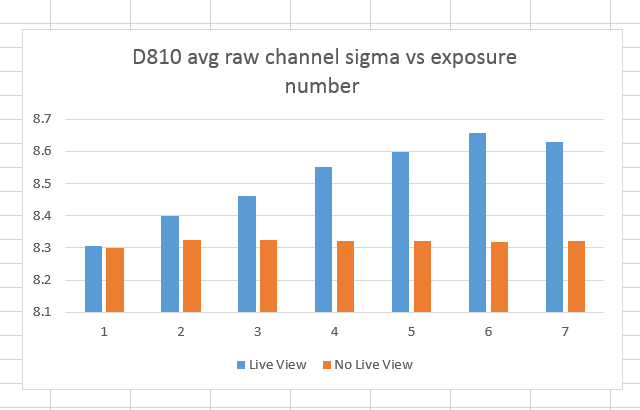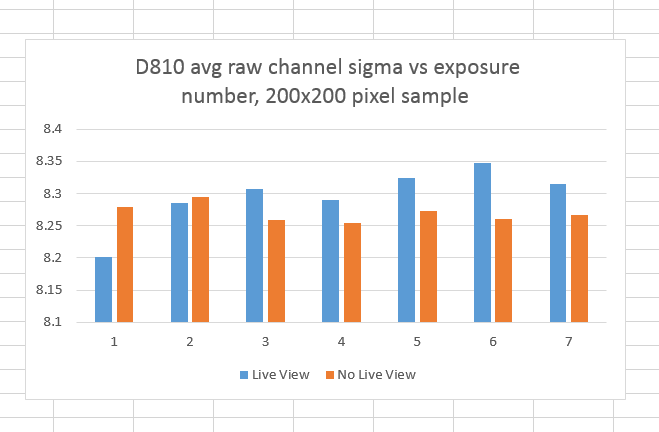It has been speculated that using live view, because it heats up the sensor, will add to the shadow noise in images, and should be avoided. An extreme twist on this point of view says that you shouldn’t use mirrorless cameras because, with the exception of the M240, their live view is on all the time, wrecking havoc on your shadows.
That didn’t sound right to me.
In a 68-degree F (20 degrees Celsius) room, I set a D810 up in manual mode, with 14 bit raw file precision. I set the ISO to 800, which is the highest ISO on the D810 where there is no clipping of dark-field images. There happened to be an Otus 85 on the camera. I left it there, secure in the knowledge that the dark field images would be of very high quality. I set the shutter to EFCS at 1/2000 second, the aperture to f/16, the shutter mode to single shot, and the exposure delay to 0. With the lens cap on, I made a series of several exposures with live view off, and another series about a minute apart with live view on.
I brought the images into RawDigger, and selected nearly the whole frame.
Here’s the histogram of the first image:
The gaps in the red and blue pixels are due to Nikon’s white balance prescaling.
I plotted the average standard deviation (aka sigma) of all four channels vs exposure number. Here’s the graph:
The vertical axis is the standard deviation measured by the ADC count. You can see that the self-heating introduced by live view is in evidence. You can also see that the effect of that heating is tiny.
If we look at just a 200×200 pixel central sample, we can see an even smaller effect, indicating that the main component of the heat-induced live view noise is pattern noise;



Thanks Jim,
I had the same fear with the LCD monitor of the Fuji X-Pro1, Olympus EM-5, Sony SLT-a65 and Sony RX-100III! I make some tests and found out that the monitor affect the image and increase the noise also by ISO100!!!
New MILC have EVF! Even, when you look through the EVF the Monitor still affect…..
To avoid noise it is better to put the monitor as much as possible away from the back. Best is a swiveling monitor!
Or to shoot without Liveview for DSLR! Best is to have a cool-pack and cooling down the back of the DSLR, it works as a wonder…..
Maybe it’s a problem for other cameras, but it looks like it’s inconsequential on the D810.
Jim
All digital camera are affected, more or less!
What I want to know:
How much noise difference between 1/8000s and 30sec?
And which shutter speed affect less? It is 1/8000s or 1/125s …? It could be interesting for continuous mode by shooting session.
Hi Jim,
I am not sure where I should post my question, so I am posting it here. It is about noise but in more practical manner.
I tried to compare the noise level in raw images from the Canon 6D and Sony A7. According to DxO mark, their normalized LowLight scores (based on SNR18) are nearly identical. The difference in pixel count (20 vs 24 Mpix) should give some slight edge to the 6D. However, when I looked at the test images (gray scale) on DPR at ISO 1600-6400, the visible difference in the image noisiness was almost 1 stop for my sight. The same held true when I downloaded the raw files from dpr and processed them in dcraw.
My question, where the truth is? Or everything is right on its own but the final images from the A7 will be noisier for some reason?
I don’t have any Canons to test. I’m not knowledgeable of the ins and outs of DxO’s testing, although it appears that they build a model and present data from the model instead of the actual measured data. If you want to compare Claff photographic dynamic range vs ISO for several cameras, I recommend you use this page:
http://home.comcast.net/~NikonD70/Charts/PDR.htm
Jim